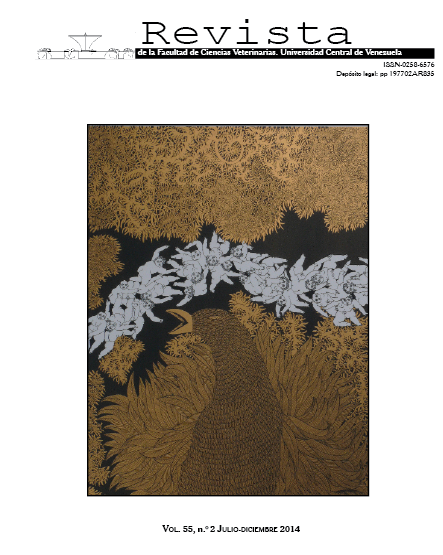PARÁMETROS Y TENDENCIAS GENÉTICAS PARA CARACTERÍSTICA DE CRECIMIENTO PREDESTETE EN UNA POBLACIÓN BOVINA MULTIRRACIAL EN COLOMBIA
Contenido principal del artículo
Resumen
El presente estudio tuvo como objetivo estimar las heredabilidades, correlaciones, heterosis y tendencias genéticas para peso al nacer (PN) y al destete ajustado (PDA; 270 d) en una población multirracial Angus×Brahman en el Trópico bajo colombiano. Se utilizaron 561 registros de pesos al nacer y al destete entre los años 1999 al 2010. Los datos fueron analizados mediante un modelo bivariado que incluyó los efectos fijos de grupo contemporáneo (año-época de nacimiento-sexo), edad de la madre, efectos genéticos directos y maternos de raza, heterosis individual y materna; y los efectos aleatorios genéticos directos y maternos del animal, ambiente permanente materno y residual. Los componentes de varianza se estimaron por el método de máxima verosimilitud restringida, mediante el programa AIREML. Las heredabilidades directas estimadas para PN y PDA fueron 0,08 ± 0,005 y 0,10 ± 0,006, respectivamente. La heredabilidad materna para PN fue de 0,04 ± 0,002 y 0,08 ± 0,005 para PDA. Se encontraron correlaciones genéticas negativas entre efectos directos y maternos para PN (-0,51 ± 0,02) y PDA (-0,21 ± 0,03) y entre efectos directos para PN y maternos para PDA (-0,50 ± 0,02). Las tendencias genéticas para efectos directos y maternos fueron cercanas a cero y no significativas (P>0,05). Las heredabilidades directas y maternas para ambas características, sugieren que se deben mejorar y homogenizar en la población las condiciones de nutrición y manejo para mejorar el crecimiento de los animales en la fase predestete. Las tendencias genéticas indican, que la intensidad de selección aplicada a esta población multirracial no fue suficiente para influir sobre los valores de cría directos y maternos durante los años de estudio.
Abstract
The aim of this study was to estimate heritabilities, correlations, heterosis, and genetic trends for birth weight (BW) and adjusted weight at weaning (AWW, 270 d) in a multibreed Angus × Brahman population in the Colombian tropical lowlands. A total of 561 records of BW and weaning weight from 1999 to 2010 were used. Data were analyzed using a bivariate model, which included the fixed effects of contemporary group (year-season of birth-sex), age of mother, direct genetic effects and maternal effects of breed, individual and maternal heterosis; and the direct and maternal genetic random effects of the animal, maternal permanent environment, and residuals. Variance components were estimated by the restricted maximum likelihood method, using the AIREML program. Estimates of direct heritability for BW and AWW were 0.08 ± 0.005 and 0.10 ± 0.006, respectively. The maternal heritability for BW was 0.04 ± 0.002 and 0.08 ± 0.005 for AWW. Negative genetic correlations were found between direct and maternal effects for BW (-0.51 ± 0.02) and AWW (-0.21 ± 0.03), and between direct effects for BW and maternal for AWW (-0.50 ± 0.02). The genetic trends for direct and maternal effects were closed to zero and not statistically significant (P>0.05). The direct and maternal heritabilities for both traits suggest that nutrition conditions and management should be improved and homogenize in the population to improve animal growth in the pre-weaning phase. Genetic trends indicate that the selection intensity applied to this multiracial population was not enough to exert an influence on the direct breeding and maternal values during the years of the study.

